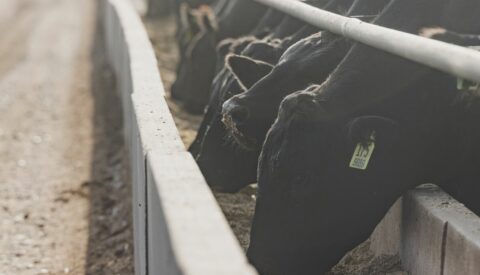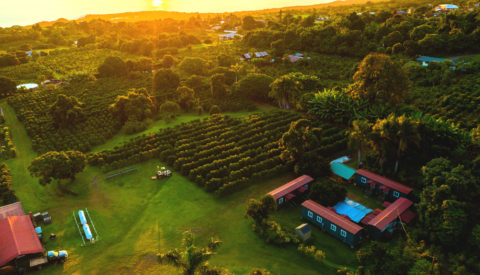The term “stagflation” continues to make headlines and weigh on consumers. Since March, more than 40% of consumers in the University of Michigan Survey of Consumers have said they expect financial conditions to worsen in the next year, and web searches for “stagflation” have jumped sharply. The agricultural sector is not immune to the buzz either. For many seasoned farmers, the word harkens back to memories of the 1980s farm crisis. Key findings from the current economic outlook: Terrain’s most-likely outlook for 2025 is slower economic growth and inflation that persists above the Federal Reserve’s 2% target — but not at stagflation levels. Today’s inflation drivers are very different from those of the 1970s and 1980s. Runaway inflation is unlikely — especially if the Federal Reserve maintains its independence from political influence, enabling it to make decisions based on economic fundamentals rather than external pressure. While U.S. economic growth dipped in the first quarter of 2025, a full-blown recession doesn’t appear imminent. Given the current economic climate likely keeping interest rates near current levels, farmers should stress-test budgets and cash flows, maintain operational discipline, carefully consider expansion, and consult with their Farm Credit lenders and risk management advisors. U.S. recessions are typically triggered by unexpected shocks, so-called “black swans,” and are often followed by disinflation or even deflation. Stagflation, by contrast, is both rare and economically devastating because it exists only when economic growth contracts while inflation accelerates sharply. The only widely recognized period of stagflation in the U.S. occurred between 1973 through 1982, a time marked by three recessions, when real gross domestic product (GDP) growth averaged just 2.3% and inflation averaged 9.2% — with the Consumer Price Index (CPI) peaking at nearly 17%. 1 One commonly used headline indicator of economic stress is the Misery Index, which is the sum of the unemployment rate and the inflation rate. The rationale is straightforward: both unemployment and inflation contribute to public economic discomfort, so their sum offers a rough gauge of overall distress. Stagflation also includes a third component: slowing economic growth. So, a simple Stagflation Index can be derived from the Misery Index minus Real U.S. GDP. The Stagflation Index began climbing in the early 1970s, peaking above 17 in 1974, and remained elevated throughout much of the decade. It surged again in 1980 to approximately 21 and stayed high until then-Federal Reserve Chair Paul Volcker successfully curbed inflation, leading to a sustained economic recovery after 1982. As of the first quarter in 2025, the Stagflation Index stands at 3.7 — comparable to levels seen during the mid-1990s. The current shape of the U.S. Treasury yield curve also indicates elevated, though not critical, stagflation concerns. From mid-2022 through late 2024, the yield curve was inverted, meaning short-term interest rates exceeded long-term rates. Historically, economic downturns have followed this pattern. As of mid-2025, the yield curve has begun to normalize slightly but remains flat, suggesting that while recession fears may be easing, investors are still uncertain about the long-term outlook for growth and inflation in the U.S. economy. Markets are not pricing in a strong recovery. Instead, they appear to be bracing for a prolonged period of economic stagnation with inflationary pressures that are proving difficult to contain. Other inflation measures, such as the 5- and-10-year breakeven inflation rates, indicate that the market expects inflation to remain stubbornly high, or above the Fed’s target of 2% inflation. The combination of prospects of elevated inflation and subdued growth is consistent with stagflation concerns. Key Stagflation Factor #1: Inflation For stagflation to take hold again, inflation would need to increase sharply and remain persistent. But is inflation currently that bad? The CPI was 2.7% in June, down significantly from its 9% peak in June 2022, and the Personal Consumption Expenditures (PCE) rate was 2.6% in June. The slowdown in CPI from the 2022 peak is largely due to slower price growth in goods, energy and food — which together made up only 13% of June’s CPI increase, compared to 62% in June 2022. Unlike the 1970s and ’80s, today’s inflation is not broad-based. In those decades, every component of the CPI rose monthly, creating a compounding effect that overwhelmed consumers. For a similar pattern to emerge now, price increases would need to accelerate across all categories at a very rapid pace. The current outlook for inflation drivers is: Food and Energy: Prices are expected to stay stable due to low energy and agricultural commodity prices (assuming Middle East and Ukraine tensions continue to abate or do not escalate). Services: Services inflation has eased from highs in 2022 and has remained stable since March of 2025, in line with slower wage growth. For example, wage growth dropped from 6.7% in June 2022 to 4.2% in June 2025. 2 Unemployment also has remained steady between 4% and 4.2% since May 2024. So, wages are unlikely to rise rapidly and be a significant driver of services inflation. 3 Shelter: Rent, home insurance, and lodging costs have remained elevated, keeping shelter inflation sticky. While home prices have dipped slightly, elevated interest rates and insurance costs continue to exert upward pressure on rents. As a result, the shelter component of inflation is expected to remain sticky through 2025. 4 Goods: The goods component of inflation presents the greatest uncertainty. Importers and exporters frontloaded shipments to avoid potential tariffs, temporarily blunting inflationary impacts. Looking ahead, the degree and speed at which companies pass costs to consumers could drive inflation higher on goods. However, the timing and magnitude of the impact are highly uncertain. The Survey of Consumer Expectations indicates that consumers expect inflation to increase 3.0% over the next year. 5 While 3.0% inflation could strain household budgets, it remains well below the 9% average inflation experienced during the stagflation era of 1973 to 1982. Overall, inflation risk remains tilted to the upside, and a modest reacceleration is possible in the latter half of 2025. However, it is unlikely that inflation will return to the extreme levels observed in 1973 to 1982, or that it will rise rapidly enough to trigger a recession and continue accelerating through an economic downturn, should one occur. Key Stagflation Factor #2: Economic Growth For stagflation to occur, economic growth also must stall. In the first quarter of 2025, U.S. GDP declined by 0.5% on an annualized basis. 1 However, this drop was largely driven by an unprecedented 4.6% drag from net exports — the biggest on record — as businesses accelerated purchases ahead of potential tariffs. The drag from net exports in the first quarter of 2025 is consistent with other, recent, one-off declines in GDP. Also like other one-off reports, GDP bounced back in the second quarter as net exports and inventories (private investment) swung back and real GDP touched 3%. Importantly, consumption remained positive in the first and second quarters: total retail and food sales in the second quarter were 0.13% higher than in the first quarter and 1.56% higher than the previous year, on an inflation-adjusted basis. Year-to-date retail and food sales are 1.6% higher than in 2024 as stronger March and June sales offset weaker January and May sales. 6 In contrast, the economic downturns from 1973 to 1982 were characterized by declines in both consumer spending and private investment. That period saw three recessions and is not yet a strong analog to today’s economic environment. Our outlook is not a full-blown recession but rather a period of slower growth and persistent inflation. While this scenario is far from ideal, it remains well below the severity of the stagflation experienced between 1973 and 1982. What Does Our Economic Environment Mean for Agriculture? For many farmers, the topic of stagflation often exhumes memories that are better left alone. 7 Between 1973 and 1982, the number of farm operations declined 17%, including a sharp 10% drop from 1974 to 1975. 8 The primary drivers were collapsing farm income, declining land values, latent policy responses, and soaring interest rates fueled by runaway inflation. Current financial conditions in some commodity-specific sectors of U.S. agriculture are showing signs of strain. For instance, the Federal Reserve Banks of Chicago and Kansas City have recorded at least six consecutive quarters of declining farm loan repayments, an indicator of mounting financial stress. Comparatively, loan repayment rates declined by over 80% of recorded observations during the 1973-1982 stagflation period. 9 Farmland values have recently begun to level off, and in some states decline slightly, after several years of consecutive gains. However, the current softening is not comparable to the sharp and prolonged downturn of land values experienced in the early 1980s. 9 For farmers, it is unlikely that the current environment will deteriorate into a repeat of the 1973 to 1982 stagflation era. However, our outlook of subdued economic growth combined with elevated inflation and interest rates is likely to challenge profit margins at the farmgate and beyond. In this economic environment, here are five planning recommendations for farmers: Stress-Test Budgets and Cash Flows Prepare for a “higher-for-longer” rate environment. Evaluate how your cash flow would perform under scenarios ranging from no rate cuts to a modest 50-basis-point reduction. Any new debt that you take on should work in today’s rate environment. If your current cash flow needs future interest rate cuts to work, consider alternative income stream options if interest rates remain sticky. Focus on Operational Discipline If you’re producing a commodity in the recovery (e.g., swine) or boom (e.g., cattle) phase of the cycle, use this time to strengthen your working capital. For those in a margin squeeze, e.g., corn, cotton, soybeans, wheat, wine, and almonds, continue seeking ways to reduce input costs, maximize yields, and lock in favorable pricing when possible. Conduct your own input audit to identify opportunities for efficiency or substitution, or implement a zero-based budgeting process as opposed to carrying over the same line items each year. Focusing on net income growth is likely to pay greater dividends than focusing on asset growth. For producers with a direct-to-consumer business line, ruthlessly consider operational efficiencies that can help offset weaker consumer demand, which could materialize in a slower economic environment. Additionally, consider further product segmentation that may capture less price-sensitive consumers. Explore Strategic Partnerships When or If Necessary Consider working with neighboring producers to share equipment, labor, or storage if applicable. These collaborations can reduce overhead and sometimes improve operational flexibility. Be Cautious with Expansion Stay alert for growth opportunities but avoid overextending on high-priced assets without clear, long-term value. Expansion should not come at the cost of leveraging the majority of your farm, off-farm savings or retirement plans. Engage with Lenders and Risk Management Advisors Collaborate closely with financial and risk management partners at Farm Credit to optimize financing and marketing strategies. Maintain a mindset of protecting against downside risks while preserving upside potential. Endnotes 1 In this article all references to CPI data are from the U.S. Bureau of Labor Statistics (https://www.bls.gov/cpi/) and the PCE data is from the U.S. Bureau of Economic Analysis (https://www.bea.gov/data/personal-consumption-expenditures-price-index). We chose to focus on CPI as it relates to the larger basket of consumer goods, however, please note that the Federal Reserve has stated that PCE is their preferred measure (https://www.federalreserve.gov/economy-at-a-glance-inflation-pce.htm). All GDP data also comes from the U.S. Bureau of Economic Analysis (https://www.bea.gov/data/gdp/gross-domestic-product). 2 Federal Reserve Bank of Atlanta, “Wage Growth Tracker,” https://www.atlantafed.org/chcs/wage-growth-tracker . 3 Bureau of Labor Statistics, “Employment Situation Summary,” May 2nd 2025, https://www.bls.gov/news.release/empsit.nr0.htm . 4 Zillow Research, “Zillow Home Value and Home Sales Forecast (June 2025),” June 12th, 2025, https://www.zillow.com/research/home-value-sales-forecast-33822/#:~:text=Zillow’s%20latest%20forecast%20indicates%20an,affordability%20should%20support%20home%20sales . 5 Federal Reserve Bank of New York, “Survey of Consumer Expectations,” June 2025, https://www.newyorkfed.org/microeconomics/sce#/ 6 Bureau of Economic Analysis, “Personal Income and Outlays, April 2025,” https://www.bea.gov/news/2025/personal-income-and-outlays-april-2025 and United States Census Bureau, “Advance Monthly Sales for Retail and Food Services,” May 15th 2025, https://www.census.gov/retail/sales.html . 7 Verbiage taken from Randy Travis, “Diggin’ Up Bones,” 1986, Warner Bros. Records. 8 USDA National Agricultural Statistics Service (NASS), 2025, Quick Stats https://quickstats.nass.usda.gov/results/F55E92E5-F523-3E45-AA49-3979966E06B9 . 9 Federal Reserve Bank of Kansas City, “Ag Credit Survey,” 2025, https://www.kansascityfed.org/agriculture/ag-credit-survey/ and Federal Reserve Bank of Chicago, “Ag Letter,” 2025, https://www.chicagofed.org/publications/agletter/index .
More Articles
See All InsightsHerd Rebuilding, Consumer Beef Spending, and Global Demand in the Grain Markets Chinese and global demand, grain price seasonality, and harvest marketing headwinds and opportunities are…
Carcass weights received a great deal of attention in 2024. But the increase in weights should be no surprise, as it follows a decades-long trend. While
“The best part of my day is waking up to a fresh cup of Kona coffee,” says Tom Greenwell, co-owner of Greenwell Farms. That cup of…



